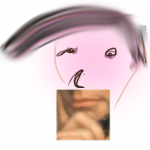I am working with our Alexandria Country Day School art teacher to design a series of field trips to Washington DC, art museums. Working to leverage the most student learning from field trips is a big goal in my professional development, so the opportunity to work with an incredibly creative art teacher is exciting.
Suzy Tacktill, our art teacher, has organized nine field trips for this school year. We took our first trip this week to the National Portrait Gallery. Our school has a buddy system with older students mentoring younger students. The 7th Graders and their 4th Grade buddies were the first group to participate. The main goal for the first trip was to have the students interact with their art and their buddies using analysis and art terms to describe art.
The trip took place over 90 minutes with the students and their buddies divided into two groups. One group visited the presidential portrait gallery, while the other visited the Bravo! and Champions exhibits. The groups then switched exhibits. The last portion of the field trip took place in the covered courtyard of the museum.
The 7th Graders prepared for the trip by downloading images we screen-captured from presidential portraits the students would be viewing in the museum. This meant that each student would have an image of a hand, a section of a face, etc., on their iPad. The next step was to have each student import the image into the ArtStudio app on their iPads and manipulate it to a canvas section. Once the student finds the portrait in the gallery and analyzes it with their buddy, the buddy team will digitally paint a new painting, starting with the presidential partial image.
Here are some examples of the art our very creative students digitally painted.
Here are the directions that Suzy wrote up for the students to structure their interaction with the presidential images and for their interaction with their buddies.
- Buddy groups look at all of the portraits of the presidents and then find the portrait that corresponds with your photo segment.
- Study the painting carefully.
- In ‘Pages’ on your iPad, make notes of adjectives that describe the painting of that president.
- Also, make notes of adjectives that describe the artist’s style. Here are some adjectives that may help you get started: happy, sad, mad, scared, frustrated, energetic, serious, relaxed, silly, calm, content, young, old, short, tall, pretty, handsome, lazy, beautiful, ugly, formal normal, elegant, sloppy, powerful, proud, kind, determined.
- Read the written explanation that accompanies the painting.
- Create a layer in ‘ArtStudio’ and complete a portrait painting around the segment of the painting that you have saved on your iPad.
- Compare your list of adjectives with those of another buddy group who was studying a different painting.
- Also, compare the styles of the artists.
- Video yourself and your buddy looking at and talking about the art.
Here are the directions for the students in the Bravo! and Champions exhibits.
- Notice and discuss the difference between portraits that are painted, photographic portraits, and sculptural portraits.
- Think about what each method of portraiture captures about the subject.
- Think about how the style of the artist influences how the portrait looks.
- Pay attention to the “bio” (biographical information) written near the portraits.
- Choose a portrait you and your buddy like because you think the person featured is interesting. Please take a photo of it. Also, photograph (or note in “Pages”) the picture’s name and the artist.
- Choose another portrait because you like the style of the artist. Also, photograph (or note in “Pages”) the picture’s name and the artist.
- Video yourself and your buddy looking at and talking about the art.
The final stage of the field trip took place in the courtyard, where the focus was on the buddy experience. Each student took a photo of their buddy and inserted it into the ArtStudio app. Drawing on one’s knowledge of their buddy, each student would then draw a new background around the photo of the buddy that depicted what they had learned about one’s buddy. After spending the previous 60 minutes viewing portraits, photographs, and sculptures of individuals, it was an excellent transfer task.


0 Comments
1 Pingback